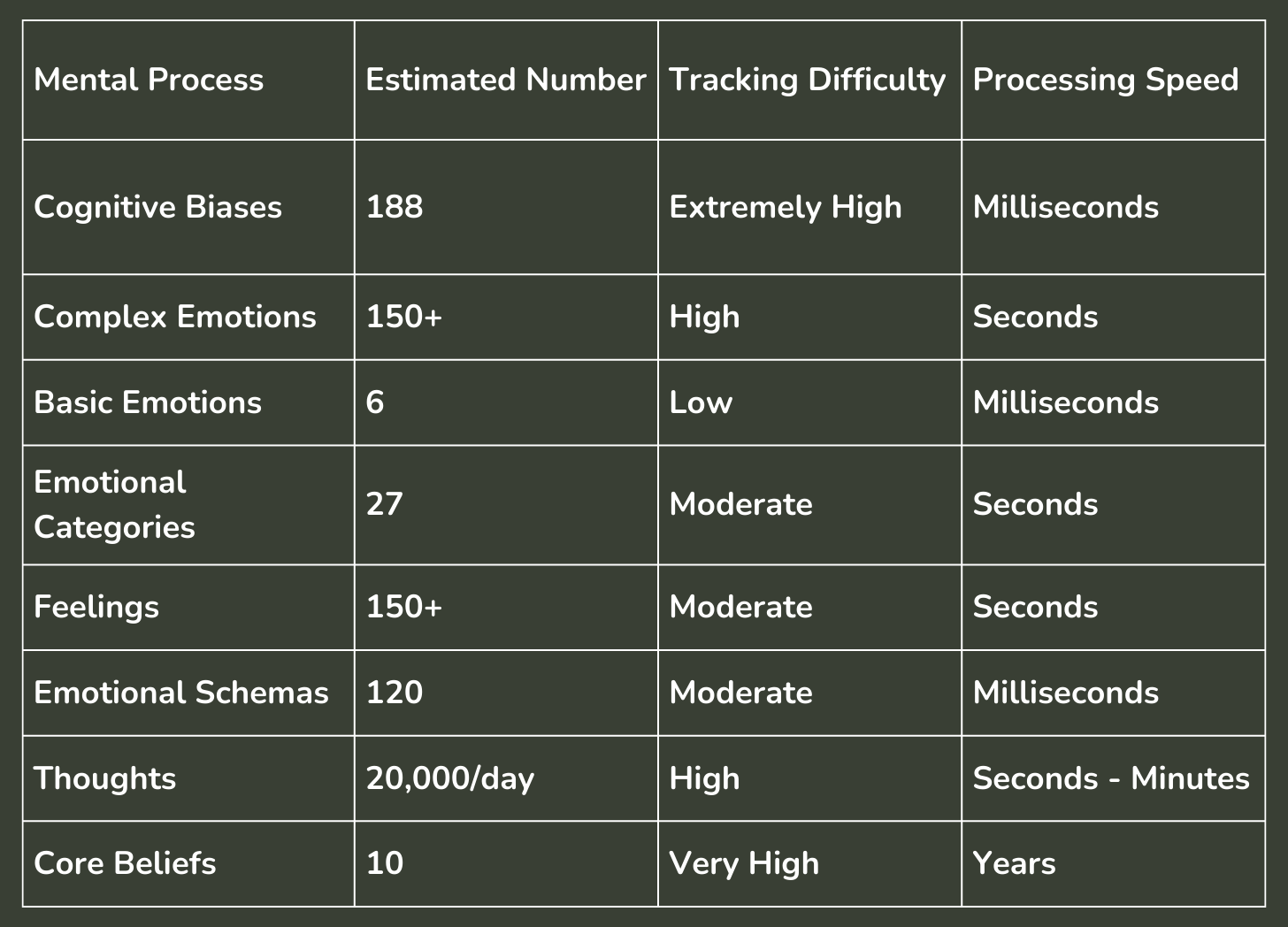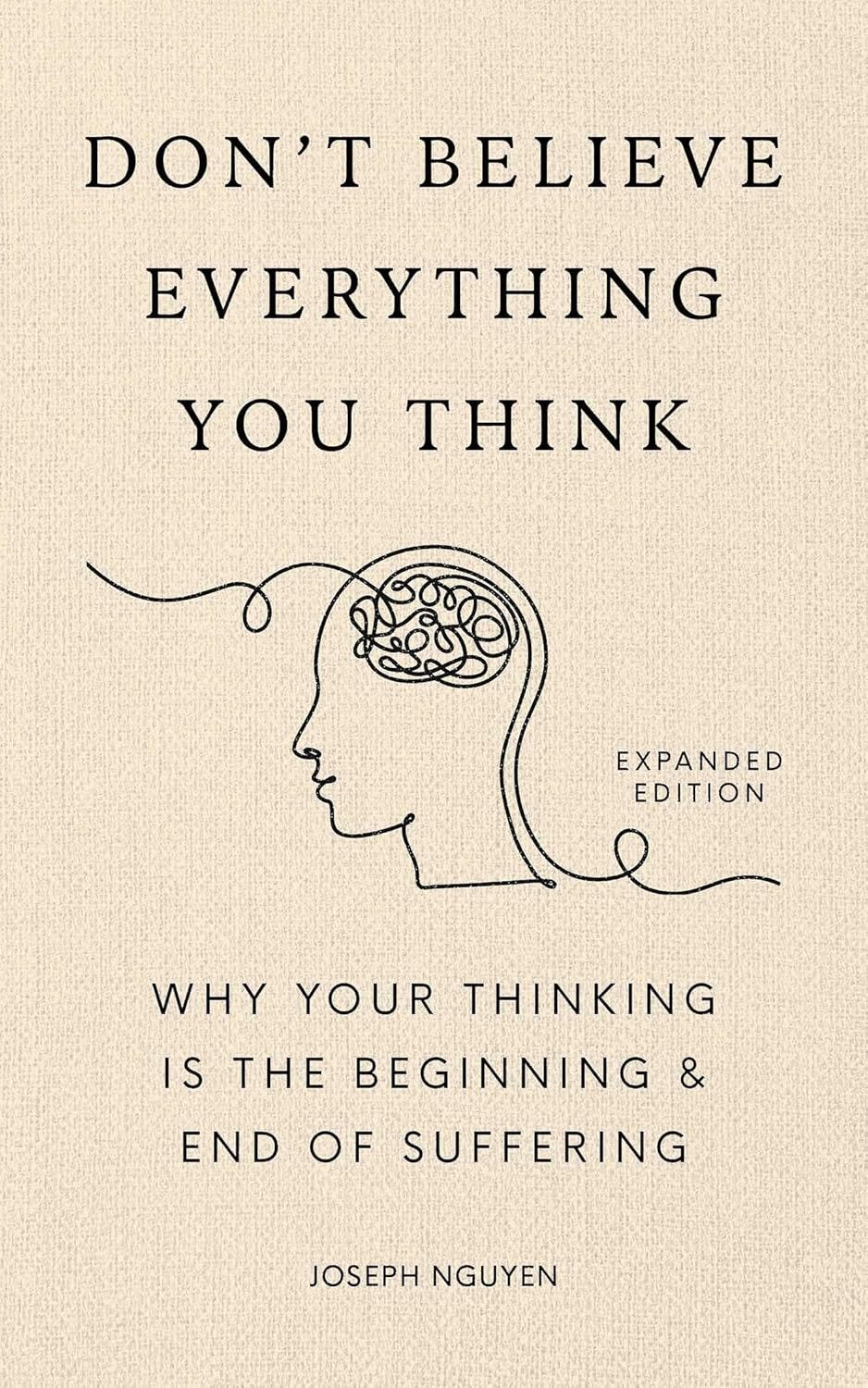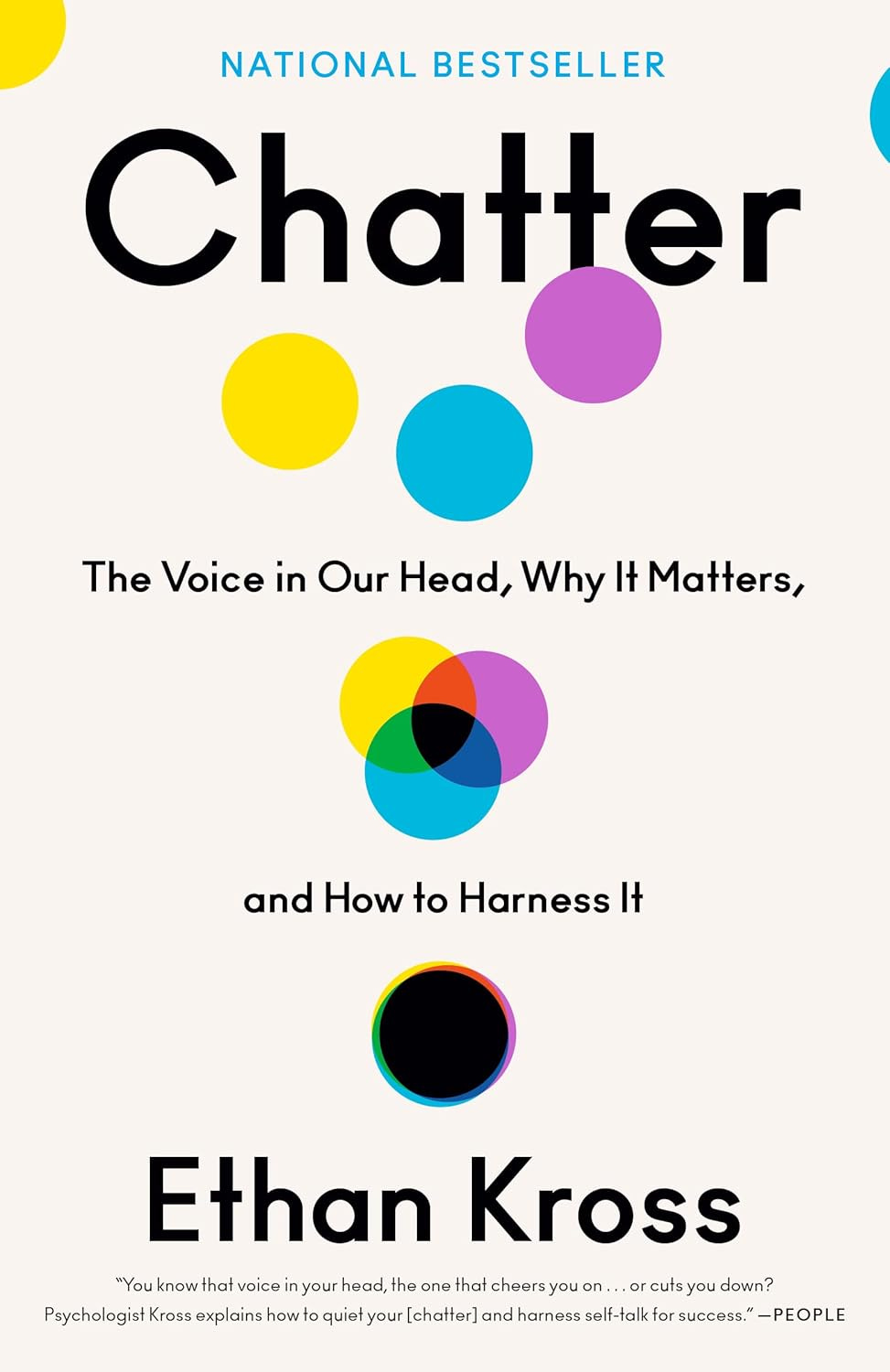🧠 Navigating Your Mind's Library: From 6 Basic Emotions to 188 Cognitive Blind Spots
Why labelling Your mind library is critical to heal and transform.
Imagine having 188 invisible filters distorting every decision you make, while only being able to spot 6 basic emotions. That's your brain on autopilot.
But here's the kicker - you're not just dealing with emotions and biases. Your mind is running a complex network of schemas, beliefs, and thought patterns that would make any supercomputer jealous.
Think you know what's driving your decisions?
Think again.In the time it took you to read this intro, your brain:
Processed 11 million bits of information
Generated 70 thoughts
Ran through dozens of cognitive biases
All while you were conscious of less than 1% of it
What if I told you that understanding this mental architecture could be the difference between breaking free from old patterns and staying stuck in loops you don't even know exist?
👉 Mental architecture literacy has been one of the key’s for me to deal effectively with negative emotions, identify emotional schemas and cognitive biases.
When you understand that your brain processes information through multiple layers - from lightning-fast emotional responses (processed in milliseconds) to deeply embedded belief systems (taking years to form) - you begin to see why simple "positive thinking" often fails.
The real power lies in understanding how these systems interact.
Welcome to your brain's control room. Let's see what's really pulling the strings.
The Real Mental Hierarchy
Your mind isn't just a thinking machine - it's a sophisticated processing network where biases hide in plain sight, emotions mask as logic, and beliefs puppet your decisions without leaving a trace.
Mental Processing Architecture
Complexity Layers
It’s important to understand the layers.
So let’s peel that magic onion.
Immediate Processing
Senses: Touch, taste, smell, sight, hearing (Processed in ~13 milliseconds)
Basic Emotions: Happy, sad, angry, afraid, disgusted, surprised (Processed in ~40 milliseconds)
Secondary Processing
Feelings: Interpretations of emotions (Processed in seconds)
Thoughts: ~60,000-70,000 daily (Processed in seconds to minutes)
Emotional Schemas: Complex emotional patterns formed from experience
Deep Processing
Core Beliefs: Fundamental assumptions about self/world
Cognitive Biases: Systematic thinking errors
Mental Models: Framework for understanding reality
That’s where you fail …The Recognition Challenge
You can understand, admin, try to fix and heal what You can Recognise.
How hard is it to recognise and IDENTIFY each experience that is happening in our brain now?
Tier 1 - Easiest to Track
Physical Sensations: Immediate bodily signals (heart rate, muscle tension)
Basic Emotions: Universal facial expressions and clear physiological patterns (anger, fear, joy)
Moods: Extended duration makes them noticeable (depression, anxiety)
Tier 2 - Moderately Difficult
Emotional Categories: More nuanced emotional states (contentment, frustration)
Feelings: Require emotional literacy and self-awareness
Emotional Schemas: Pattern recognition across situations
Thoughts (Need mindfulness practice)
Tier 3 - Most Challenging
Cognitive Biases: Operate automatically without conscious awareness
Core Beliefs: Deeply embedded, often invisible to self
Complex Emotional Patterns: Interaction between multiple emotional states
This hierarchical understanding helps explain why cognitive biases and core beliefs are the most resistant to change - they operate at the deepest level of our mental architecture, often invisible to our conscious awareness while simultaneously influencing all other levels of processing.
Let me break down real-world examples of identification challenges across all tiers:
Tier 1 Challenges (Supposedly "Easy" to Track)
Physical Sensations
A racing heartbeat could be misinterpreted as anxiety when it's actually from physical exertion
Stress-related muscle tension builds so gradually that people often don't notice until they're experiencing pain
During illness, it becomes particularly challenging to distinguish whether symptoms like fatigue are emotional or physical in origin
Basic Emotions
What appears as surprise on someone's face might actually be fear, leading to misidentification of basic emotions
During intense experiences like grief, people often feel multiple conflicting emotions simultaneously
Cultural differences can cause fundamental misreading of emotional expressions
Tier 2 Complexities
Emotional Categories
People often resort to vague terms like feeling "off" or "meh" instead of identifying specific emotions
Relationship conflicts arise when frustration is mistakenly expressed as anger
Surface happiness might mask underlying sadness or stress
Feelings
Past experiences heavily influence current feelings, making it difficult to separate historical responses from present ones
Limited emotional vocabulary can prevent accurate identification of feelings
Self-judgment often leads to dismissal of valid feelings like envy
Tier 3 Deep-Rooted Challenges
Cognitive Biases
Confirmation bias makes people only notice evidence supporting their existing beliefs
Attribution bias causes incorrect assessment of success and failure reasons
Emotional discussions often trigger unconscious biases in interpreting others' actions
Core Beliefs
Many people are unaware that their belief of being unlovable affects their relationships
Deep-seated beliefs are often invisible yet powerfully influence decision-making
Uncovering core beliefs can be so uncomfortable that people resist the process
The complexity of mental misinterpretations runs deeper than we initially assumed and affects all of use.
Expanding our emotional vocabulary and exploring our core believes can be the most transforming experience.
If You look at manifestation practises, most of them rely on simply identifying negative core believes and then changing them to positive.
Mastering Your Mind's Control Panel:
A Tier-by-Tier Guide to Mental Mastery
Tier 1: Mastering the Basics
Start with what's most accessible - your physical sensations and basic emotions. When you feel your heart racing or muscles tensing, pause and label the sensation. Practice connecting these bodily signals to the six basic emotions (happiness, sadness, fear, disgust, anger, surprise) that trigger them.
The key is quick recognition: your body processes these in milliseconds, so catching them early gives you maximum control[1].
Set aside two 5-minute periods daily to scan your body and name what you're feeling. This builds your foundation for emotional literacy[2].
The great thing about body scanning it works not just as a recognition but
Tier 2: Navigating the Middle Ground
Once you've mastered basic recognition, dive deeper into emotional categories and feelings. Use an emotion wheel to expand your emotional vocabulary beyond basic labels. Start journaling about your emotional experiences, noting not just what you feel, but the thoughts that accompany these feelings. This tier requires patience - you're working with processes that take seconds to minutes to unfold[3].
Practice identifying emotional schemas by looking for patterns in your reactions across similar situations. The goal isn't to change these patterns yet, but to become aware of them[4].
Tier 3: Conquering the Complex
This is where the real transformation happens. To master cognitive biases, start by accepting that they exist - we all have them. Practice metacognition (thinking about your thinking) by questioning your immediate reactions to situations.
For core beliefs, use the "downward arrow" technique: keep asking "what does this mean about me?" until you hit a fundamental belief.
The key is persistence - these patterns took years to form and require consistent attention to modify[5].
Remember, you're working with your brain's deepest operating system, so changes here will affect everything else[6].
Integration: The Master Key
True mastery comes from working all three tiers simultaneously. When you feel a strong emotion (Tier 1), trace it to its associated feeling pattern (Tier 2), then examine the underlying beliefs and biases driving it (Tier 3). This creates a feedback loop that strengthens your overall emotional intelligence and decision-making capacity. Think of it as upgrading your mental operating system - each level of awareness enhances the others.
📚 Great books to Recognise Your Brain’s Motions
☕ You are not alone. How different therapies works on Recognition Mastery?
This is just an example how Schema Therapy, Cognitive Behavioural Therapy and Dialectical Behavior Therapy (DBT) approaches each tier.
Tier 1 (Basic Recognition)
DBT's mindfulness practices for immediate awareness
CBT's body scanning techniques
Schema therapy's experiential exercises
Tier 2 (Pattern Recognition)
CBT's cognitive restructuring
DBT's emotion regulation skills
Schema therapy's pattern identification
Tier 3 (Complex Processing)
Schema therapy's core belief work
CBT's behavioral experiments
DBT's interpersonal effectiveness training
Each therapeutic approach offers unique tools for mastering different aspects of mental processing, while working together to create a comprehensive system for understanding and managing your mind's complex architecture.
Therapy is powerful when You are open to it and don’t treat it just as a dialogue with a friend. It can make You your mind recognition master, and recognition master easily becomes a a positive change master.
Think of therapy not as a conversation, but as an elite training program for your brain's operating system. While a friend might offer comfort, a therapist is more like a neural architect, helping you decode the 188 cognitive biases, 27 emotional patterns, and countless thought loops that secretly drive your decisions.
Every session is a masterclass in mental recognition, where you're not just talking - you're rewiring neural pathways that have been running on autopilot for years.
Marbella Reed, Cognitive Spa & Comforts
Citations:
[1] https://www.nirandfar.com/be-your-best-self/
[2] https://mindwellnyc.com/the-ultimate-guide-to-understanding-your-feelings-emotions-for-2022/
[3] https://www.modernmindmasters.com/how-to-control-emotions/
[4] https://positivepsychology.com/cognitive-biases/
[5] https://pmc.ncbi.nlm.nih.gov/articles/PMC8475916/
[6] https://www.6seconds.org/2022/07/15/emotion-feeling-mood/








